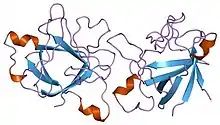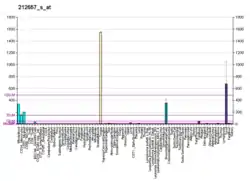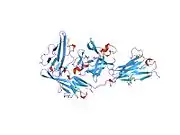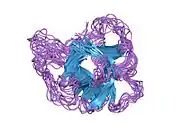The interleukin-1 receptor antagonist protein (IL-1RN) is a protein that in humans is encoded by the IL1RN gene.[5][6]
IL-1RN was initially called the IL-1 inhibitor and was discovered separately in 1984 by two independent laboratories.[7] IL-1RN is an agent that binds non-productively to the cell surface interleukin-1 receptor (IL-1R), the same receptor that binds interleukin 1 family (IL-1), preventing IL-1's from sending a signal to that cell.
Function
IL-1RA is a member of the interleukin 1 cytokine family. IL1Ra is secreted by various types of cells including immune cells, epithelial cells, and adipocytes, and is a natural inhibitor of the pro-inflammatory effect of IL1β.[8] This protein inhibits the activities of interleukin 1, alpha (IL1A) and interleukin 1, beta (IL1B), and modulates a variety of interleukin 1 related immune and inflammatory responses. This gene and five other closely related cytokine genes form a gene cluster spanning approximately 400 kb on chromosome 2. Four alternatively spliced transcript variants encoding distinct isoforms have been reported.[9]
Clinical significance
A polymorphism of this gene is reported to be associated with increased risk of osteoporotic fractures[10] and gastric cancer.[11]
Mutations in the IL1RN gene results in a rare disease called deficiency of the interleukin-1–receptor antagonist (DIRA).[12] Variants of the IL1RN gene is also associated with risk of schizophrenia.[13][14] Elevated levels of IL1RN has been found in serum of schizophrenia patients.[15]
A recombinant, slightly modified version of interleukin 1 receptor antagonist called anakinra is used in the treatment of rheumatoid arthritis, an autoimmune disease in which IL-1 plays a key role.[16] Anakinra differs from native human IL-1Ra in that it has the addition of a single methionine residue at its amino terminus [17]
Use in horses
Interleukin 1 receptor antagonist is used in horses for the treatment of equine lameness secondary to joint and soft-tissue injury.
References
- 1 2 3 GRCh38: Ensembl release 89: ENSG00000136689 - Ensembl, May 2017
- 1 2 3 GRCm38: Ensembl release 89: ENSMUSG00000026981 - Ensembl, May 2017
- ↑ "Human PubMed Reference:". National Center for Biotechnology Information, U.S. National Library of Medicine.
- ↑ "Mouse PubMed Reference:". National Center for Biotechnology Information, U.S. National Library of Medicine.
- ↑ Steinkasserer A, Spurr NK, Cox S, Jeggo P, Sim RB (July 1992). "The human IL-1 receptor antagonist gene (IL1RN) maps to chromosome 2q14-q21, in the region of the IL-1 alpha and IL-1 beta loci". Genomics. 13 (3): 654–7. doi:10.1016/0888-7543(92)90137-H. PMID 1386337.
- ↑ Patterson D, Jones C, Hart I, Bleskan J, Berger R, Geyer D, Eisenberg SP, Smith MF, Arend WP (January 1993). "The human interleukin-1 receptor antagonist (IL1RN) gene is located in the chromosome 2q14 region". Genomics. 15 (1): 173–6. doi:10.1006/geno.1993.1025. PMID 8432529.
- ↑ Dinarello CA (December 1994). "The interleukin-1 family: 10 years of discovery". FASEB J. 8 (15): 1314–25. doi:10.1096/fasebj.8.15.8001745. PMID 8001745. S2CID 10404996.
- ↑ Perrier S, Darakhshan F, Hajduch E (November 2006). "IL-1 receptor antagonist in metabolic diseases: Dr Jekyll or Mr Hyde?". FEBS Lett. 580 (27): 6289–94. doi:10.1016/j.febslet.2006.10.061. PMID 17097645. S2CID 23087836.
- ↑ "Entrez Gene: IL1RN interleukin 1 receptor antagonist".
- ↑ Langdahl BL, Løkke E, Carstens M, Stenkjaer LL, Eriksen EF (March 2000). "Osteoporotic fractures are associated with an 86-base pair repeat polymorphism in the interleukin-1--receptor antagonist gene but not with polymorphisms in the interleukin-1beta gene". J. Bone Miner. Res. 15 (3): 402–14. doi:10.1359/jbmr.2000.15.3.402. PMID 10750554. S2CID 23035139.
- ↑ El-Omar EM, Carrington M, Chow WH, McColl KE, Bream JH, Young HA, Herrera J, Lissowska J, Yuan CC, Rothman N, Lanyon G, Martin M, Fraumeni JF, Rabkin CS (March 2000). "Interleukin-1 polymorphisms associated with increased risk of gastric cancer". Nature. 404 (6776): 398–402. doi:10.1038/35006081. PMID 10746728. S2CID 1288472.
- ↑ Aksentijevich I, Masters SL, Ferguson PJ, Dancey P, Frenkel J, van Royen-Kerkhoff A, Laxer R, Tedgård U, Cowen EW, Pham TH, Booty M, Estes JD, Sandler NG, Plass N, Stone DL, Turner ML, Hill S, Butman JA, Schneider R, Babyn P, El-Shanti HI, Pope E, Barron K, Bing X, Laurence A, Lee CC, Chapelle D, Clarke GI, Ohson K, Nicholson M, Gadina M, Yang B, Korman BD, Gregersen PK, van Hagen PM, Hak AE, Huizing M, Rahman P, Douek DC, Remmers EF, Kastner DL, Goldbach-Mansky R (June 2009). "An Autoinflammatory Disease with Deficiency of the Interleukin-1–Receptor Antagonist". N. Engl. J. Med. 360 (23): 2426–37. doi:10.1056/NEJMoa0807865. PMC 2876877. PMID 19494218.
- ↑ Kim SJ, Lee HJ, Koo HG, Kim JW, Song JY, Kim MK, Shin DH, Jin SY, Hong MS, Park HJ, Yoon SH, Park HK, Chung JH (September 2004). "Impact of IL-1 receptor antagonist gene polymorphism on schizophrenia and bipolar disorder". Psychiatr. Genet. 14 (3): 165–7. doi:10.1097/00041444-200409000-00009. PMID 15318032. S2CID 43435475.
- ↑ Zanardini R, Bocchio-Chiavetto L, Scassellati C, Bonvicini C, Tura GB, Rossi G, Perez J, Gennarelli M (2003). "Association between IL-1beta -511C/T and IL-1RA (86bp)n repeats polymorphisms and schizophrenia". J Psychiatr Res. 37 (6): 457–62. doi:10.1016/S0022-3956(03)00072-4. PMID 14563376.
- ↑ Hope S, Melle I, Aukrust P, Steen NE, Birkenaes AB, Lorentzen S, Agartz I, Ueland T, Andreassen OA (November 2009). "Similar immune profile in bipolar disorder and schizophrenia: selective increase in soluble tumor necrosis factor receptor I and von Willebrand factor". Bipolar Disord. 11 (7): 726–34. doi:10.1111/j.1399-5618.2009.00757.x. hdl:10852/34620. PMID 19839997.
- ↑ Mertens M, Singh JA (January 2009). "Anakinra for rheumatoid arthritis". The Cochrane Database of Systematic Reviews (1): CD005121. doi:10.1002/14651858.CD005121.pub3. PMID 19160248.
- ↑ "Kineret (anakinra) injection, for subcutaneous use" (PDF). Swedish Orphan Biovitrum.
Further reading
- Arend WP, Malyak M, Guthridge CJ, Gabay C (1998). "Interleukin-1 receptor antagonist: role in biology". Annu. Rev. Immunol. 16: 27–55. doi:10.1146/annurev.immunol.16.1.27. PMID 9597123.
- Adcock IM, Ito K (2000). "Molecular mechanisms of corticosteroid actions". Monaldi Archives for Chest Disease. 55 (3): 256–66. PMID 10948677.
- Arend WP (2003). "The balance between IL-1 and IL-1Ra in disease". Cytokine Growth Factor Rev. 13 (4–5): 323–40. doi:10.1016/S1359-6101(02)00020-5. PMID 12220547.
- Sehouli J, Mustea A, Könsgen D, et al. (2003). "Polymorphism of IL-1 receptor antagonist gene: role in cancer". Anticancer Res. 22 (6A): 3421–4. PMID 12530098.
- Kamangar F, Cheng C, Abnet CC, Rabkin CS (2007). "Interleukin-1B polymorphisms and gastric cancer risk--a meta-analysis". Cancer Epidemiol. Biomarkers Prev. 15 (10): 1920–8. doi:10.1158/1055-9965.EPI-06-0267. PMID 17035400. S2CID 8542733.
External links
- Interleukin+1+Receptor+Antagonist+Protein at the U.S. National Library of Medicine Medical Subject Headings (MeSH)









